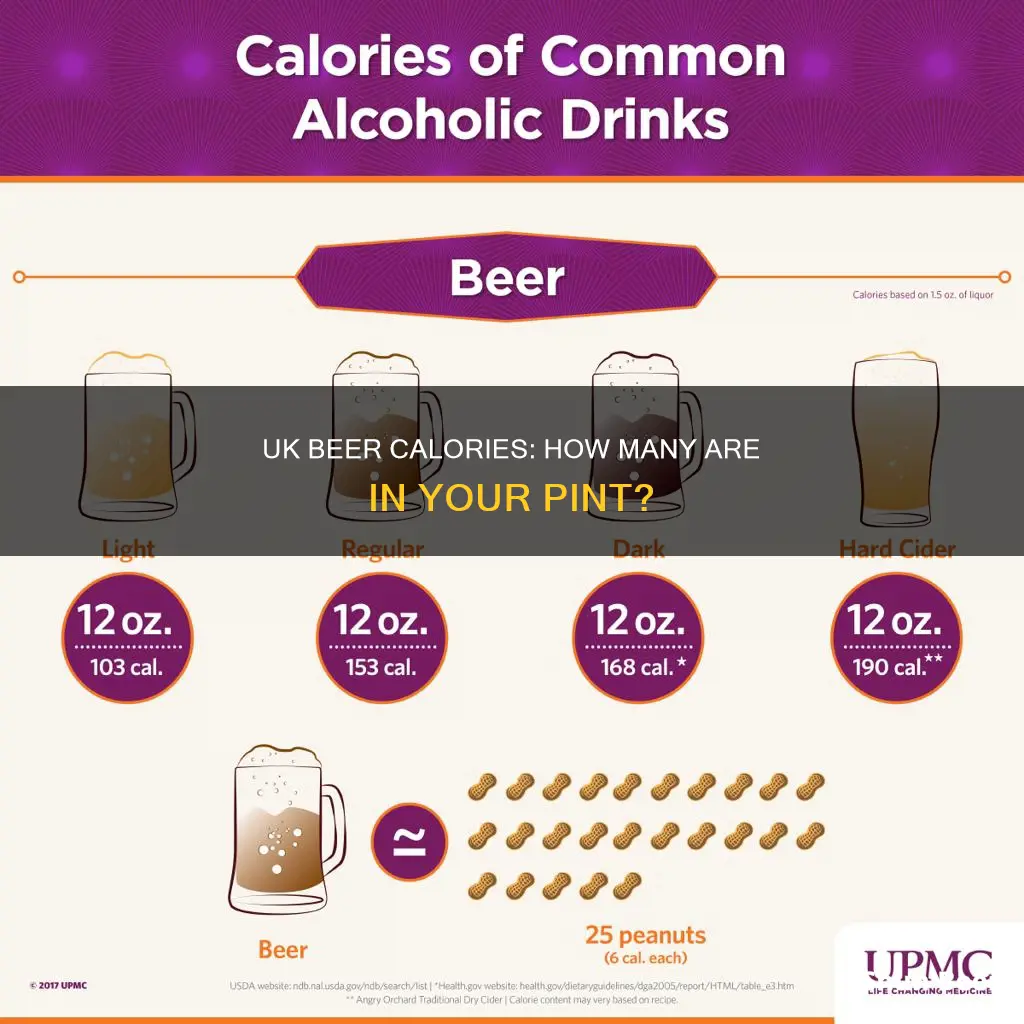
Beer is a popular drink, but it can be high in calories. The number of calories in a beer depends on the serving size, type of beer, and its alcohol content. On average, a typical pint of beer contains around 215 calories, but this can vary from 188 to 257 calories per pint across different brands and styles. The prevailing opinion is that the darker the beer and the denser the head, the more calories it contains. However, this is not always the case, as some lighter-coloured lagers can have more calories than darker beers. Beer calories come mainly from alcohol and carbohydrates, with about 60% of beer calories coming from alcohol and the rest from carbs. Alcohol has seven calories per gram, almost as many as pure fat. So, if you're watching your weight, it's important to be mindful of the calorie content of your beer.
Characteristics of Calories in Beer in the UK
| Characteristics | Values |
|---|---|
| Average calories in a pint of beer | 215 |
| Calories in a bottle of beer | 122-154 |
| Calories in a can of beer | 139-149 |
| Calories in a 330ml serving of light beer | 64-102 |
| Calories in a 330ml serving of non-alcoholic beer | 69-73 |
| Calories in a 330ml bottle of low-calorie beer | 89 |
| Calories in a 330ml can of low-calorie beer | 99 |
| Calories in a pint of strong lager | 235 |
| Calories in a pint of dry cider | 225 |
| Calories in a pint of mid-strength lager | 200 |
| Calories in a 350ml bottle of small beer lager | 77 |
| Calories in a 330ml bottle of low-calorie beer | 80-90 |
| Calories in a pint of beer with 5% ABV | 250 |
What You'll Learn
- Calories in beer mainly come from alcohol and carbohydrates
- Alcohol has more calories per gram than carbohydrates
- Lagers tend to have fewer carbs than ales, which in turn have fewer than stouts
- The darker the beer and denser the head, the more calories it contains
- Alcohol-free beers usually contain fewer calories

Calories in beer mainly come from alcohol and carbohydrates
Beer is made from fermented grain, and the calories in beer mainly come from alcohol and carbohydrates. Alcohol has a higher number of calories per gram than carbohydrates, so alcohol content has the most significant impact on the overall calorie count. A higher alcohol content will result in more calories. For example, a 12-ounce beer that is 4% ABV has about 150 calories, with 14 grams of alcohol and 13 grams of carbs.
Beer is believed to have originated in the Middle East almost 5,000 years ago and was first commercially produced in Germany, Austria, and England in the 13th century. Today, it is a popular drink worldwide and a massive part of the food and beverage industry. Beer tends to be higher in calories than wine or spirits, and it is often referred to as "empty calories" due to its lack of nutritional value.
The number of calories in beer can vary depending on the type and brand. For instance, a 330ml bottle of Budweiser contains 145 calories, while a bottle of the same size of Coors has 149 calories. The prevailing opinion is that darker beers with denser heads contain more carbs and calories, but this is not always the case. For example, Skinny Lager has significantly fewer calories than regular lager brands like Kronenbourg, Peroni, and Budweiser.
If you are watching your calorie intake, opting for low-calorie beers or non-alcoholic beers can be a good choice. These beers have a lower alcohol content, resulting in fewer calories. Additionally, drinking in moderation and pairing your beer with a low-calorie meal can help you manage your overall calorie consumption.
Calories in Beer: Understanding the ABV Connection
You may want to see also

Alcohol has more calories per gram than carbohydrates
Alcohol has a higher number of calories per gram than carbohydrates. Alcohol contains seven calories per gram, while carbohydrates contain only four. This means that alcoholic drinks can contribute a significant amount of calories to your diet, and drinking too much can impact your waistline.
Alcoholic drinks are made from natural starch and sugar, and the fermentation process (or distillation for certain drinks) is used to produce the alcohol content. The calorie count in a drink depends on the alcohol levels and the sugar/carbohydrate content, with alcohol having the most impact. Pure alcohol contains more calories per gram than carbohydrates, but less than fat, which has nine calories per gram.
The prevailing opinion is that the darker the beer and the denser the head, the more carbs and calories it contains. However, this is not always the case. For example, Skinny Lager has 39% fewer calories than a bottle of Kronenbourg, and 37% fewer calories than a bottle of Peroni.
The calorie content of beer varies depending on the brand and type. For instance, a 330ml bottle of Budweiser contains 145 calories, while a bottle of Coors contains 149 calories. The average pint of 5% strength beer contains around 215 calories.
If you're trying to lose weight, it's important to consider not only what you're eating but also what you're drinking. Alcoholic drinks can be high in calories and can contribute to weight gain. It's also worth noting that alcohol can delay the fat-burning process. When consumed, the body prioritises processing and eliminating alcohol as it is viewed as a toxin. This means that the burning of other substances, including stored fats, is halted.
Air-Fried Beer-Battered Onion Rings: A Calorie Conundrum
You may want to see also

Lagers tend to have fewer carbs than ales, which in turn have fewer than stouts
The number of calories in a pint of beer varies depending on the type of beer, its alcohol content, and how it's brewed. Lagers tend to have fewer carbs than ales, and ales tend to have fewer carbs than stouts.
Lagers are typically lighter in calories than ales and stouts. Ordinary strength lagers have around 170 calories per pint, while premium lagers can have up to 338 calories per pint. Ales have around 180 calories per pint, and stouts have approximately 210 calories per pint.
The calorie count in beer is influenced by the alcohol volume percentage (ABV) and the sugar/carbohydrate content. Alcohol has about 7 calories per gram, and carbohydrates, mostly from brewing grains, add more calories. The Homebrewer's Association estimates that about 60% of beer calories come from alcohol, with the remaining 40% coming from carbs.
Some sources suggest that darker and denser beers tend to have more carbs and calories. However, this is not always the case, as some lighter-coloured beers can have higher sugar content and, therefore, more calories.
When it comes to specific brands, Skinny Lager is a popular choice for those watching their calorie intake. It has 39-34% fewer calories than a bottle of regular lager, such as Kronenbourg, Peroni, or Budweiser.
In conclusion, lagers generally have fewer carbs and calories than ales and stouts, but it's important to consider the ABV and sugar content when making comparisons between different types of beer.
Calories in Heineken Beer: Nutritional Facts and Figures
You may want to see also

The darker the beer and denser the head, the more calories it contains
It's a common misconception that the darker the beer, the more calories it contains. This misconception likely stems from the fact that darker beers are typically associated with being richer and heavier. While it is true that the colour of beer is directly related to its malt content, with darker malts yielding brown and light black colours, as well as chocolate and coffee flavours, the colour of the malt does not affect the alcohol content or the number of residual carbohydrates in the beer.
In fact, the number of calories in beer is dependent upon alcohol levels and sugar/carbohydrate content, with alcohol having the most impact due to the higher number of calories per gram in alcohol than in carbohydrates. So, while it is true that darker beers tend to have a higher alcohol content and, therefore, more calories, this is not always the case. For example, a light-bodied Samuel Adams Black Lager with 4.9% ABV is estimated to have under 200 calories in a 12-oz serving, while a very pale Victory Brewing Co.'s Golden Monkey Belgian-style tripel with 9.5% ABV is estimated to have over 300 calories in a 12-oz serving.
Additionally, black lagers (schwarzbiers), porters, and drier stouts tend to have a similar number of calories to pale beers. For instance, a serving of Guinness, a dark beer, has 125 calories, while a Bud Light, a light beer, has 110 calories.
Therefore, when it comes to determining the calorie content of a beer, it is important to look beyond the colour and consider the alcohol content and the sugar/carbohydrate content.
Calorie-Rich Tripel Beer: How Many Calories in One?
You may want to see also

Alcohol-free beers usually contain fewer calories
The calories in beer come from two sources: alcohol and carbohydrates. According to the Homebrewer's Association, about 60% of beer calories come from alcohol, and the rest come from carbs.
Therefore, it makes sense that non-alcoholic beers will be lower in calories. For example, a 330ml bottle of standard Heineken (5%) contains 139 calories, whereas a 330ml bottle of Heineken "0.0" (0%) contains 69 calories. Similarly, a 330ml bottle of Carlsberg (3.8%) contains 122 calories, while a 330ml bottle of Carlsberg "0.0" (0%) contains 73 calories.
If you're watching your weight or simply want to take better care of yourself, opting for alcohol-free beers is a good way to reduce your calorie intake. However, it's important to note that the taste of non-alcoholic beers may be different from their alcoholic counterparts, and some people may prefer the taste of regular beer.
In addition to alcohol content, the number of calories in a beer also depends on the type of beer and its sugar and carbohydrate content. Lagers, for instance, tend to contain fewer carbs than ales, which in turn have fewer carbs than stouts. However, this is not always the case, as some lagers may contain as many calories as a dark beer.
Calories in Schofferhofer: Grapefruit Beer Breakdown
You may want to see also







